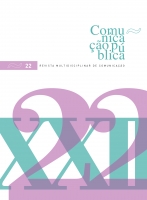Digital media and rights
Perspectives of young people with cancer
DOI:
https://doi.org/10.4000/cp.1387Keywords:
children and young people, cancer, digital media, rights, privacyAbstract
This article presents the main results of an exploratory study on the uses and perceptions of digital media by Portuguese young people who have or had an oncological disease, using the theoretical framework of children’s rights, digital literacy, and health media literacy. With the purpose of discussing, in particular, the ways in which the young people use social networking sites and how they manage their privacy or visibility while sick with cancer or after the recovery, we conducted three focus groups with 12 participants between 13 and 22 years-old. Digital offer this group opportunities for entertainment and contact during and after treatments, but pose challenges to the quality of health information they find online and to the privacy they want to have, especially during treatments.
Downloads
References
Borzekowski, D. L. (2009). Considering children and health literacy: a theoretical approach. Pediatrics, 124(Supplement 3): 282-288. DOI : 10.1542/peds.2009-1162D good / bad
Buckingham, D. (2008). Youth, Identity, and Digital Media. Cambridge: MIT Press.
Buckingham, D., Ed. (1993). Reading Audiences: Young People and the Media. Grã-Bretanha: Manchester University Press.
Buckingham, D. e Willett, R. (2006). Digital Generations: Children, Young People, and New Media. Nova Jersey: Lawrence Erlbaum Associates Publishers.
Carvalho, R., Sampaio, I. e Marôpo, L. (2016). Entre a dor e a superação: adolescentes com câncer discutem sua representação nas notícias. Animus. Revista Interamericana de Comunicação Mediática, 15 (30): 224-240. DOI : 10.5902/2175497719171 good / bad
Creswell, J. (2003). Research Design: Qualitative, Quantitative, and Mixed Methods Approaches. Londres, Nova Iorque: Sage.
Dixon-Woods, M., Young, B. e Heney, D. (2005). Rethinking Experiences Of Childhood Cancer: A Multidisciplinary Approach To Chronic Childhood Illness. Reino Unido: McGraw-Hill Education.
Drotner, K. (1992). Modernity and media panics. In: Skovmand, M. e K. C. Schroder, eds. Media Cultures Reappraising Transnational Media. Londres, Nova Iorque: Routledge: 42-62.
Gerbner, G. (1994). Reclaiming our cultural mythology. Context, 38: 40-42.
Higgins, J. W. e Begoray, D. (2012). Exploring the borderlands between media and health: Conceptualizing ‘critical media health literacy’. Journal of Media Literacy Education, 4 (2): 136-148.
James, A. e Prout, A. (orgs.) (1997). Constructing and Reconstructing Childhood. Londres: Routledge. DOI : 10.4324/9780203362600 good / bad
Jorge, A. (2014). ‘O Que é Que os Famosos Têm de Especial?’ - A Cultura das Celebridades e os Jovens. Alfragide: Texto Editores.
Levin-Zamir, D., Lemish, D. e Gofin, R. (2011). Media health literacy (MHL): Development and measurement of the concept among adolescents. Health Education Research, 26 (2): 323-335. DOI : 10.1093/her/cyr007 good / bad
Levy, M. L. (1996). Os direitos da criança hospitalizada. Acta Pediátrica Portuguesa, 27 (4): 655-657.
Livingstone, S. (2016). Reframing media effects in terms of children’s rights in the digital age. Journal of Children and Media, 10 (1): 4-12.
DOI : 10.1080/17482798.2015.1123164 good / bad
Livingstone, S. (2014). Children's digital rights: a priority. Intermedia, 42 (4/5): 20-24. [Internet] Disponível em < http://eprints.lse.ac.uk/60727/>
Livingstone, S. e Haddon, L. (2014). Kids Online: Opportunities and Risks for Children. Lisboa: Policy Press.
Livingstone, S. (1998). Mediated childhood: A comparative approach to young people’s changing media environment in Europe. European Journal of Communication, 13 (4): 435-456. DOI : 10.1177/0267323198013004001 good / bad
Lobe, B., Livingstone, S., Olafsson, K. e Simões, J. A. (2008). Best practice research guide: how to research children and online technologies in comparative perspective. EU Kids Online, Londres.
Manganello, J. A. (2008). Health literacy and adolescents: a framework and agenda for future research. Health Education Research, 23 (5): 840-847. DOI : 10.1093/her/cym069 good / bad
Marôpo, L. (2014). Identidade e estigmatização: as notícias na perceção de crianças e jovens de um bairro de realojamento. Análise Social, 210, XLIX (1º): 104-127.
Ponte, C. (2012). Crianças & Media: Pesquisa Internacional e Contexto Português do Século XIX à Actualidade. Lisboa: Imprensa de Ciências Sociais.
Prensky, M. (2001). Digital natives, Digital immigrants. On the Horizon, 9 (5): 1-6.
Schroder, K., Drotner, K., Kline, S. & Murray, C. (2003). Researching Audiences: A Practical Guide to Methods in Media Audience Analysis. Lisboa: Arnold.
Soares, N. F. (2005). Infância e direitos: participação das crianças nos contextos de vida – representações, práticas e poderes. Tese de Doutoramento em Estudos da Criança – Ramo do Conhecimento em Sociologia da Infância, Universidade do Minho. Portugal.
Von Feilitzen, C. e Stenersen, J. (Eds.) (2014). Young People, Media and Health: Risks and Rights. Gotemburgo: Nordicom.
Woodward, K. (1997). Identity and Difference – Culture, Media and Identities. Londres: Sage Publications e Open University.
Downloads
Published
Issue
Section
License
Copyright (c) 2017 Direitos do Autor (c) 2017

This work is licensed under a Creative Commons Attribution-NonCommercial 4.0 International License.
Os conteúdos da Comunicação Pública estão licenciados com uma licença Creative Commons - Atribuição-NãoComercial 4.0 Internacional.


